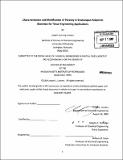| dc.contributor.advisor | Gregory C. Rutledge. | en_US |
| dc.contributor.author | Lowery, Joseph Lenning | en_US |
| dc.contributor.other | Massachusetts Institute of Technology. Dept. of Chemical Engineering. | en_US |
| dc.date.accessioned | 2010-04-28T17:04:52Z | |
| dc.date.available | 2010-04-28T17:04:52Z | |
| dc.date.copyright | 2009 | en_US |
| dc.date.issued | 2009 | en_US |
| dc.identifier.uri | http://hdl.handle.net/1721.1/54582 | |
| dc.description | Thesis (Ph. D.)--Massachusetts Institute of Technology, Dept. of Chemical Engineering, 2009. | en_US |
| dc.description | Cataloged from PDF version of thesis. | en_US |
| dc.description | Includes bibliographical references. | en_US |
| dc.description.abstract | The process of charging a polymer solution to draw a filament is known as electrospinning. Electrospinning is capable of producing a continuously depositing jet of controllable micron and sub-micron diameters. As fiber deposits, a nonwoven mat of randomly oriented fibers in two dimensions is generated. The mat is mechanically robust and suitable for a wide variety of applications due to its high surface area to mass ratio, controllable size scale and surface chemistry, and large void fraction. The number of publications on the topic of electrospinning continues to grow exponentially, as the experimental apparatus is relatively inexpensive to assemble and 1 mm thick fiber mats can be generated in as little as 2 hours. Many publications have focused on potential applications or the processing of specific materials. Some publications have reported on the hydrodynamics and physics of the electrospinning process, leading to an increased control of fiber diameter and morphology. One area that remains relatively unexplored is pore diameter and porosity within the fiber mat. The present work explores characterizing and controlling void space in electrospun materials and the use of these materials in the field of tissue engineering. Characterization and prediction of overall void fraction and individual pore diameter is first addressed. Mercury porosimetry was used to establish two physical parameters useful in electrospinning applications: average pore diameter and peak pore diameter. Average pore diameter refers to the volume-weighted average determined by the volumetric profile. Peak pore diameter is the pore diameter at which the largest amount of void volume becomes accessible. | en_US |
| dc.description.abstract | (cont.) The accuracy of mercury porosimetry was also addressed, leading to a method of data correction for buckling of pores under the significant pressure generated by mercury porosimetry. Having characterized and predicted the void statistics for as-spun materials, the second portion of this work sought to use post-processing techniques to alter the effective pore diameter. Two components - poly(E-caprolactone) and poly(ethylene oxide) - were electrospun together, either from a common polymer solution or adjacent fluid jets on to a common target. Water was used to selectively remove the poly(ethylene oxide) component in both systems, with vastly different results. Mats electrospun from a common solution saw an increasing reduction in the void diameter with increasing poly(ethylene oxide) removal due to poly(E-caprolactone) chain rearrangement and contraction of the polymer fibers, up to a pore diameter reduction of 80%. Mats produced by the dual jet method saw both an increase and decrease of the effective pore diameter depending on processing conditions. These experiments represent the first steps by researchers to specifically tailor pore diameter independent of porosity or fiber diameter. The final portion of this thesis deals with the use of electrospun materials as 3-Dimensional tissue engineering scaffolds. An effective perfusion technique was developed for the seeding and infiltration of cells into multiple electrospun mats simultaneously, with 100% efficiency. This represents an enormous advantage over conventional seeding methods. | en_US |
| dc.description.abstract | (cont.) Human Dermal Fibroblasts were seeded into scaffolds of drastically varied fiber diameter (300nm to 8 [mu]m) and morphology (beaded vs. uniform diameter). Despite cells spreading along large fibers instead of developing multiple attachment points between fibers, cell proliferation was greatest in scaffolds with pore diameters greater than 6 [mu]m. At the same time, mats with pore diameters less than 12 pm observed the greatest extracellular matrix growth. Additional investigation would be well-served to determine optimal parameters for cell dispersion and reproduction throughout the electrospun template across multiple cell phenotypes. | en_US |
| dc.description.statementofresponsibility | by Joseph Lenning Lowery. | en_US |
| dc.format.extent | 202 p. | en_US |
| dc.language.iso | eng | en_US |
| dc.publisher | Massachusetts Institute of Technology | en_US |
| dc.rights | M.I.T. theses are protected by
copyright. They may be viewed from this source for any purpose, but
reproduction or distribution in any format is prohibited without written
permission. See provided URL for inquiries about permission. | en_US |
| dc.rights.uri | http://dspace.mit.edu/handle/1721.1/7582 | en_US |
| dc.subject | Chemical Engineering. | en_US |
| dc.title | Characterization and modification of porosity in electrospun polymeric materials for tissue engineering applications | en_US |
| dc.type | Thesis | en_US |
| dc.description.degree | Ph.D. | en_US |
| dc.contributor.department | Massachusetts Institute of Technology. Department of Chemical Engineering | |
| dc.identifier.oclc | 568401776 | en_US |
